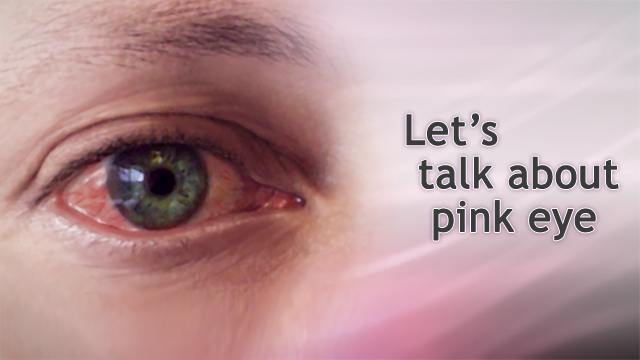Pink Eye

What is Pink Eye?
Pink eye, also known as conjunctivitis, is an inflammation or infection of the transparent membrane (conjunctiva) that lines the eyelid and covers the white part of the eyeball. This inflammation causes blood vessels to become more visible, which gives the eye a pink or reddish appearance.
Who's at risk for Pink Eye?
Anyone can develop pink eye, but certain factors may increase the risk. Children in daycare or school settings, individuals with allergies, and people who wear contact lenses are more susceptible to contracting pink eye.
What causes Pink Eye?
Pink eye can be caused by various factors, including bacteria, viruses, allergens, and irritants. The most common cause is a viral or bacterial infection. Allergic conjunctivitis occurs when the body reacts to allergens, such as pollen or pet dander. Irritants like smoke, chemicals, or foreign objects in the eye can also cause inflammation.
How does Pink Eye start?
Pink eye usually starts when the conjunctiva comes into contact with an irritant or infectious agent. In the case of viral or bacterial pink eye, the infection can be transmitted through direct contact with contaminated hands, objects, or surfaces, as well as through respiratory droplets from coughing or sneezing.
What are the symptoms of Pink Eye?
Symptoms of pink eye can include redness, itchiness, a gritty feeling, discharge, tearing, and sensitivity to light. The symptoms may vary depending on the cause of the inflammation or infection.
How is Pink Eye diagnosed?
A healthcare provider can usually diagnose pink eye based on the patient's symptoms, medical history, and a physical examination. In some cases, a sample of the discharge may be collected and sent to a laboratory for further testing to identify the specific cause.
How can Pink Eye be treated?
Treatment for pink eye depends on the cause. Bacterial conjunctivitis may require antibiotic eye drops or ointment, while viral conjunctivitis typically resolves on its own within 7-14 days. Allergic conjunctivitis can be managed with antihistamines, decongestants, or anti-inflammatory medications. In cases of irritant-induced pink eye, flushing the eye with water or saline solution can help alleviate symptoms.
What complications may occur with Pink Eye?
Complications from pink eye are rare, but they can occur. These may include an infection spreading to other parts of the eye, corneal ulcers, or vision loss if left untreated. If symptoms worsen or don't improve after several days, consult a healthcare provider.
How can I prevent Pink Eye?
Prevention measures include practicing good hygiene, avoiding contact with infected individuals, not sharing personal items like towels or makeup, and washing hands frequently. For those with allergies, managing allergen exposure and taking prescribed medications can help reduce the risk of developing allergic conjunctivitis.
Long-term management of Pink Eye
Pink eye is typically a short-term condition that resolves with appropriate treatment. Long-term management focuses on preventing recurrence through hygiene practices and allergen control.
What is recent research saying about Pink Eye?
Recent research has explored new treatment options for viral conjunctivitis, including antiviral medications, and the potential role of probiotics in maintaining eye health and preventing bacterial conjunctivitis.
Where can I go for more information on Pink Eye?
For more information on pink eye, consult your healthcare provider or visit reputable websites like the American Academy of Ophthalmology or the Centers for Disease Control and Prevention.

